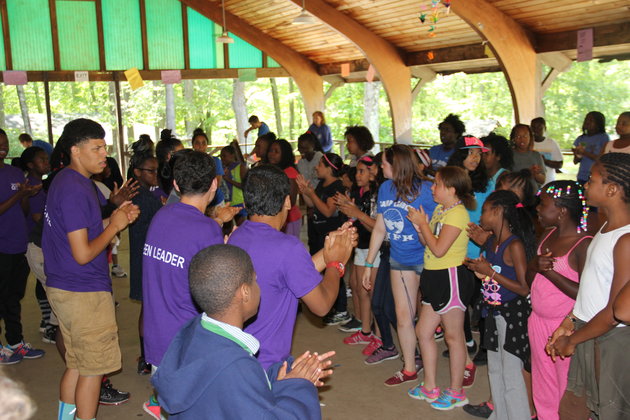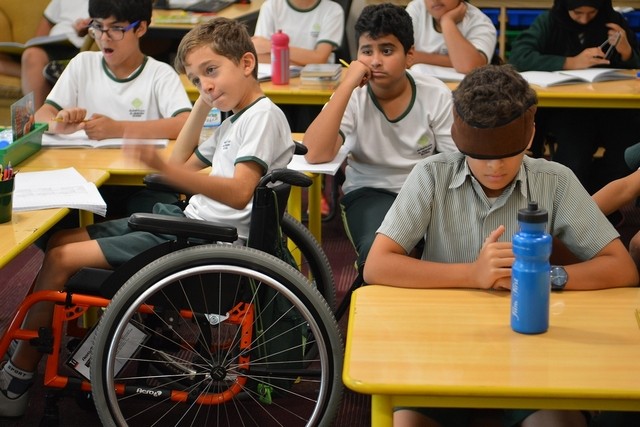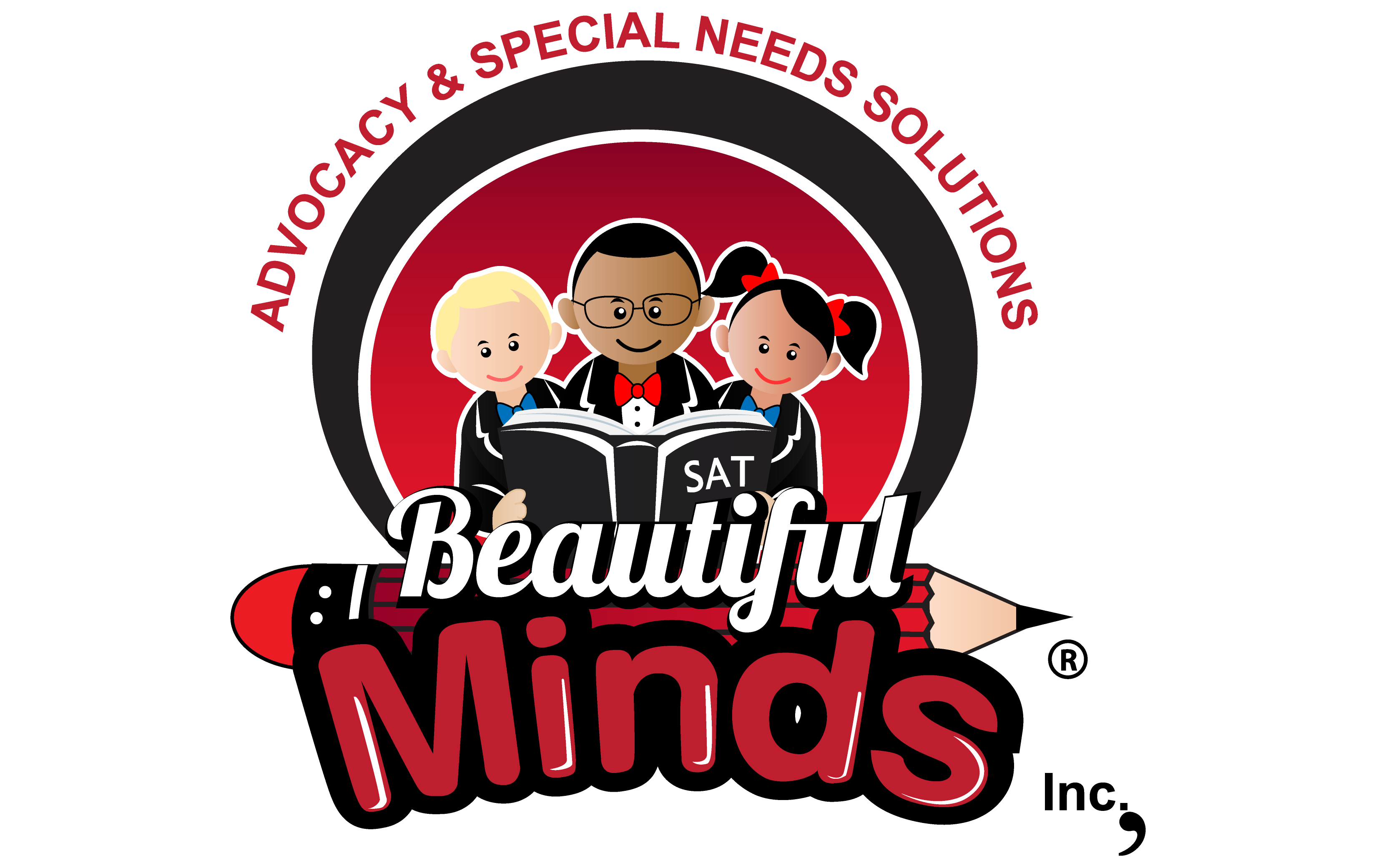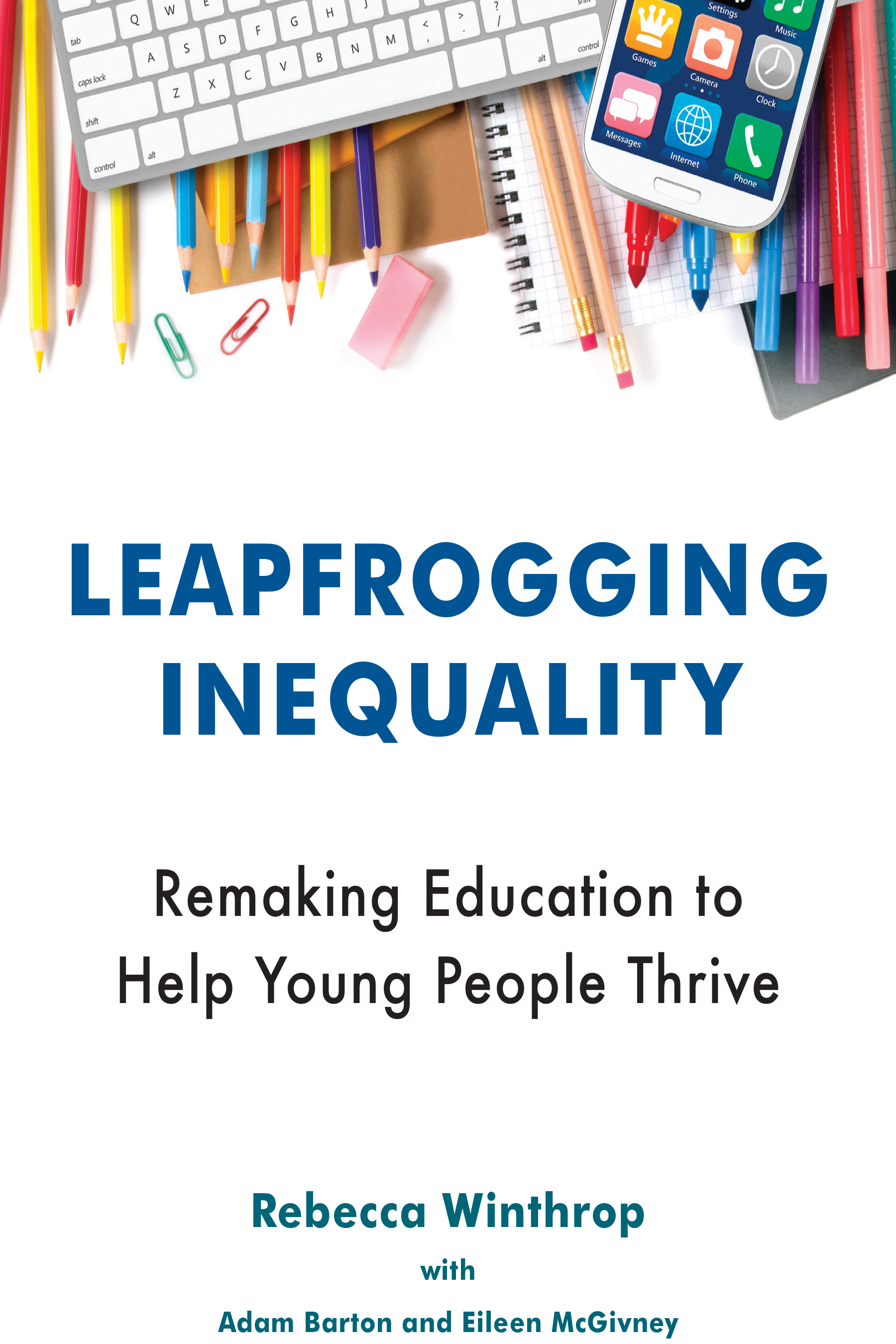New research by Morgan, Farkas, Hillemeier and Maczuga once again finds that when you take other student characteristics—notably family income and achievement—into account, racial and ethnic minority students are less likely to be identified for special education than white students.[1] Though this finding is by now well established, it remains sufficiently controversial to generate substantial media buzz.[2] And plenty of research—with less convincing methods—has been interpreted as showing that too many blacks, especially boys, are identified for special education.[3] The old conventional wisdom may be intuitively appealing because aggregate disability rates—with no adjustments for family income or other student characteristics—are higher for students who are black (1.4 times) or Native American (1.7), and lower for whites (0.9) and Asians (0.5), with Hispanic students about as likely to be identified as the rest of the population.[4]
These unadjusted ratios answer the important descriptive question of how student experience varies by race. But they do not tell us whether schools are giving black students the free and appropriate public education the Individuals with Disabilities Education Act (IDEA) guarantees them. To answer this question, we must compare the likelihood that a black student participates in special education with that of an otherwise identical white student. In other words, we don’t just want to know if black students are more likely to be in special education than whites; we want to know if black students are too likely to be in special education—or, as it turns out, not likely enough.
The conventional wisdom that blacks are over identified for special education may finally be losing ground among academics, but continues to influence public opinion and be reflected in federal law and policy. I recap this academic debate, and briefly review some major disparities we observe along racial and ethnic lines in income and other non-school factors likely to influence the need for special education by the time children enter school. I argue against fixed thresholds for how much variance states should tolerate in districts’ special education identification rates across racial and ethnic groups, and for comprehensive social policies to help address disparities in children’s well being.
THE DEBATE OVER OVER REPRESENTATION IN SPECIAL EDUCATION
In a 2002 National Research Council study, Donovan and Cross reviewed the literature and data on differences in special education participation by disability and racial/ethnic groups and cautioned against using unadjusted aggregate group-level identification rates to guide public policy.[5] They crystallized the challenge of interpreting these differences: “If… we are asking whether the number identified is in proportion to those whose achievement or behavior indicates a need for special supports, then the question is one for which no database currently exists.”[6]
Differences in aggregation, covariates, and samples generate different answers to the question of whether black students are over- or under-identified for special education.[7] The most credible studies allow researchers to control for a rich set of student-level characteristics, rather than using data aggregated to the district level, and firmly establish that blacks are disproportionately under-represented.
In 2010, Hibel, Farkas, and Morgan used the Early Childhood Longitudinal Study – Kindergarten Cohort (ECLS-K) 1998 and its follow-up waves to come closer to the ideal scenario described by Donovan and Cross.[8] While individual-level models controlling only for race and gender showed blacks more likely to be identified, adding a family socioeconomic status variable eliminated the effect of race for blacks, while Hispanics and Asians were significantly less likely to be in special education. Adding a student test score made blacks less likely to be identified; Hispanics and Asians remained less likely to be identified as well.
A follow up study found this result applied across the five disability classifications studied, notably including emotional disturbance and intellectual disability, stigmatizing categories in which black boys are over represented in the aggregate, unadjusted data.[9] While some have questioned the generalizability of the ECLS-K results due to sampling,[10] the qualitative result has been replicated using the National Assessment of Educational Progress (the 2017 Morgan et al. study), the Education Longitudinal Study of 2002,[11] and the ECLS-Birth Cohort.[12] These national patterns do not preclude local heterogeneity. Sullivan and Bal studied one Midwestern urban school district and found that while socioeconomic controls attenuate the impact of race, black students remain more likely than others to be identified for special education; they did not include student achievement as a covariate.[13]
THE “RIGHT” LEVEL OF IDENTIFICATION
Special education identification practices vary widely across and within states and districts – we do not know a “right” level. Few if any experts would argue that existing identification practices are ideal, or that identification rates reflect true prevalence of need. Beyond achievement and demographics, researchers have found that identification rates vary with school finance environments[14] and state accountability frameworks.[15]
If you view participation in special education as providing critical services to appropriately identified students, the fact that a given black student is less likely to be placed in special education than an otherwise identical white student is deeply troubling. We do not want to live in a society where parents describe access to dyslexia (or other) services as “a rich man’s game.”[16] It’s less troubling for those who view special education as stigmatizing and punitive, even for students who are appropriately identified — and indeed, we have little understanding of how well or poorly special education serves its students.
FEDERAL POLICY ON DISPROPORTIONALITY
The Individuals with Disabilities Education Act aims to address equity by race and ethnicity; 2016 regulations further define the framework.[17][18] States must collect and review district-level data on how rates of identification—overall, by educational setting and disability category—vary across racial and ethnic groups with no adjustments for variables that correlate with need for services. If the gaps between groups exceed state-determined thresholds for “significant disproportionality,” the state must examine local policies and require the district to devote more of its federal special education funds to early intervention.[19]
While states will get to set their own cut-off risk ratios, they are highly unlikely to choose ratios that require uniform representation across groups. Each state then applies that threshold to all its districts. That means a district in which blacks and whites have similar poverty rates will be subject to the same threshold as one (in the same state) in which blacks have much lower income than whites.
 REPORTING BY RACE AND ETHNICITY IS CRITICAL
REPORTING BY RACE AND ETHNICITY IS CRITICAL
Data on identification by race and ethnicity are essential for revealing patterns and outliers. They can prod districts and states to examine their special education policies and practices, potentially identifying ones that unintentionally yield discriminatory results, and shine a light on groups in need of greater early intervention resources.
According to Dr. Ifeanyi Ufondu, Educational Psychologist and Founder of Beautiful Minds Inc. – Advocacy & Special Needs Solutions, “The preamble to the disproportionality regulations notes that unequal autism identification rates across groups may reflect disparities in access to medical care, suggesting that the district offer early developmental screenings.” Indeed, research shows that among Medicaid-eligible children with autism diagnoses, white children are diagnosed over a year earlier than black children.[20]
We do not want to live in a biased society where parents describe access to dyslexia (or other) services as “a rich man’s game.”
Dr. Ifeanyi A. Ufondu, Founder of Beautiful Minds Inc. – Advocacy & Special Needs Solutions
The Department of Education’s guidance notes that significant disproportionality could result from “appropriate identification, with higher prevalence of a disability, among a particular racial or ethnic group.” In other words, exceeding the risk ratio could be appropriate and acceptable: this level of nuance could easily be missed, while the state’s numeric threshold remains salient.[21]The result could be states and districts feeling pressured to produce equal rates of identification across groups—by denying services to students who need them. Unsurprisingly, Morgan and Farkas have argued against these regulations while offering up their own alternatives.[22]
UNADJUSTED DISPROPORTIONALITY REFLECTS MORE THAN EDUCATIONAL PRACTICES
Even if schools treated all students the same, special education identification rates would likely differ across racial and ethnic groups. The disproportionality literature consistently notes that children’s outcomes are causally affected by out-of-school factors such as poor nutrition, stress, and exposure to environmental toxins, and that exposure to these influences unduly affects poor children and children of color. The unfortunate implication of this—that true prevalence of disability may be higher for these students—can get lost in the back and forth over measurement, sampling, and other methodological issues. Some numbers are worth noting:
- Black children were three times as likely to live in poor families as white children in 2015. 12 percent of white and Asian children lived in poor families, compared with 36 percent of black children, 30 percent of Hispanic children, 33 percent of American Indian children, and 19 percent of others.[23]
- Food insecurity affects 23 percent of black-headed households and 19 percent of Hispanic-headed households, compared with 9 percent of households headed by whites.
- Black children are over twice as likely to have elevated blood lead levels as whites, and low-income children over three times as likely as others.[25]
- The poor are more likely to live near hazardous waste sites.[26]
WE NEED MORE COMPREHENSIVE SOCIAL POLICY TO HELP DISADVANTAGED CHILDREN
We need to work towards better identification practices in special education. We also need to help states and districts collect and report race- and ethnicity-specific rates. But forcing states to establish uniform standards is dangerously inconsistent with the IDEA mandate of a free and appropriate public education for all. When identifying another student pushes a district over a risk ratio threshold, the district faces a clear incentive to under identify—that is, to withhold services from—children who already face a broad array of systemic disadvantages.
Instead, we should focus on building a better safety net and reducing child poverty. Luckily, policymakers have plenty of proven levers: expand income support for families as the EITC,[27] reduce food insecurity while improving maternal health and birth outcomes through a robust SNAP,[28] maintain children’s access to Medicaid,[29] and continue to work towards improving the equity and quality of general education.[30]
While encouraging school districts to avoid “disproportionality” surely comes from an idealistic place, schools cannot do it alone. Ignoring the harsh realities of racial disparities outside of school is likely to hurt those very children advocates seek to protect.
Dr. Ifeanyi Ufondu’s Top 5 Things to Know About Racial and Cultural Disparities in Special Education
By: Dr Ifeanyi Ufondu, Ph.D.
Each year, roughly 6 million students with disabilities, ages 6 to 21, receive services under the Individuals with Disabilities Education Act (IDEA). Although special education is a source of critical services and supports for these students, students of color with disabilities still face a number of obstacles impeding their ability to succeed in school. According to Dr. Ifeanyi Ufondu, Ph.D., Educational Psychologist and founder of Beautiful Minds Inc. – Advocacy & Special Needs Solutions, “In 2017, only 4 percent of black and Hispanic 12th -grade students with disabilities achieved proficiency in reading, while practically none of those students achieved proficiency in math or science. This is where the problem begin!”
In late December 2017, the U.S. Department of Education issued final rules to prompt states to proactively address racial and ethnic disparities in the identification, placement, and discipline of children with disabilities. That same month, they released comprehensive legal guidance describing schools’ obligations under federal civil rights and disabilities studies not to discriminate on the basis of race, color, or national origin in the administration of special education. To help educators, school communities, and education officials understand the challenges prompting these initiatives, here are Dr. Ufondu’s five critical facts about racial and ethnic disparities in special education:
There are wide disparities in disability identification by race and ethnicity.
In general, students of color are disproportionately overrepresentedamong children with disabilities: black students are 40 percent more likely, and American Indian students are 70 percent more likely, to be identified as having disabilities than are their peers. The overrepresentation of particular demographics varies depending on the type of disability, and disparities are particularly prevalent for so-called high-incidence disabilities, including specific learning disabilities and intellectual disabilities. Black students are twice as likely to be identified as having emotional disturbance and intellectual disability as their peers. American Indian students are twice as likely to be identified as having specific learning disabilities, and four times as likely to be identified as having developmental delays. Research does not support the conclusion that race and cultural disproportionality in special education is due to differences in socioeconomic status between groups. Efforts to reduce disparity, then, should support more widespread screening for developmental delays among young children, and should assist educators in identifying disabilities early and appropriately to address student needs. One study found that 4-year-old black children were also disproportionately underrepresented in early childhood special education and early intervention programs.
Many children of color with disabilities experience a segregated education system.
While children with disabilities have been placed in more inclusive education settings since the early 1990s, progress toward inclusion has not improved over the last decade, specifically. To ensure greatest access to rigorous academic content, IDEA statute requires that children with disabilities receive their education in the least restrictive environment, alongside children without disabilities to the maximum extent appropriate. However, in 2014, children of color with disabilities—including 17 percent of black students, and 21 percent of Asian students—were placed in the regular classroom, on average, less than 40 percent of the school day. By comparison, 11 percent of white and American Indian or Alaskan Native children with disabilities were similarly placed.
In a single year, 1 in 5 black, American Indian, and multiracial boys with disabilities were suspended from school.
According to the U.S. Department of Education’s 2013 to 2014 Civil Rights Data Collection, students with disabilities (12 percent) are twice as likely as their peers without disabilities (5 percent) to receive at least one out-of-school suspension. Suspension from school is associated with an increased risk of dropout, grade retention, and contact with the juvenile justice system. To ensure students’ access to a free and appropriate public education, as promised by IDEA, schools should take care to address both academic and behavioral needs in the development of students’ individualized education programs (IEPs).
IDEA provisions intended to address racial and ethnic disparities are underused.
For example, Section 618(d) of IDEA requires states to identify school districts with significant disproportionality, by race or ethnicity, in the identification, placement, or discipline of children with disabilities. Such school districts must reserve 15 percent of federal funds provided under IDEA, Part B to implement comprehensive, coordinated early intervening services to address the disparity. However, according to the U.S. Department of Education and the U.S. Government Accountability Office, each year, 3 percent or less of all school districts are identified as having significant disproportionality. In 2013, 75 percent of the identified school districts were located in seven states. That same year, 22 states did not identify any districtswith significant disproportionality. While there is no consensus definition of significant disproportionality – as the term refers to an IDEA legal standard, to be decided on by states, the U.S. Department of Education published preliminary data identifying extensive racial and ethnic disparities in every state in the union. Under the new final rule from the U.S. Department of Education, all states will be required to follow a standard approach to define and identify significant disproportionality in school districts.
Greater flexibility to implement comprehensive, coordinated early intervening services (CEIS) may help school districts address special education disparities, and improve academic outcomes for children of color with disabilities.
Historically, school districts with significant disproportionality were prohibited from using comprehensive CEIS to address the needs of preschool children or children with disabilities. Such restrictions would have prevented schools from using comprehensive CEIS for training IEP teams to build better behavioral supports into students’ IEPs, even to address placement or discipline disparities. Such restrictions would also have prevented efforts to identify and serve preschool children in order to prevent future disparities in disability identification. Under the new final rule, school districts may implement comprehensive CEIS in a manner that addresses identified racial and ethnic disparities, which may include activities that support students with disabilities and preschool children.
By: Dr. Ifeanyi Ufondu, June 27th, 2018
“I hate this place. I want to come home. Send my iPod. Pat the dog.”
For my entire adult life, I toiled in the vineyards of residential special education. I served as a teacher, coach, administrator and Director of residential schools that served children and adolescents with learning disabilities. This intensive experience gave me a unique window into the lives of these kids…and their families.
Upon reflection, I realize now that early in my career, I was fairly insensitive (or, at least, unresponsive to) the needs of families that were “sending their kids away” for the first time. I was unaware of the tremendous impact that the child’s absence had on the day-to-day dynamics of a family. I was certainly aware of how greatly the child would miss his family…but was only vaguely cognizant of how deeply the family would miss the child. I understood the logistics of a child’s departure from the homefront (“pack plenty of socks, some stamps and extra batteries….”) but I did not fully understand the emotionality of it all.
That all changed in 2016 when our oldest son Neiko went off to college. Everything changed with his departure. Everything. I missed his upbeat morning greeting (“Hey, Dad. What’s up?”). I missed his excited dinnertime recounting of Basketball practices; I missed the nightly ritual of wishing each other “G’night”; I missed tearing articles of mutual interest from the newspaper and placing them on his bed; I missed…greatly…his company. His temporary departure left a hole.

At that time, I began to gain a greater appreciation and empathy for the families that sent their kids to my school. Everything changes when a child leaves home and parents must design a whole new system of communicating with and caring for the absent child.
If your child is away at camp, you doubtless understand this and are trying to adapt to this situation. Perhaps a suggestion or two would help.
When you discuss your child’s camp experiences with him (or with others!) be aware of your wording. There is a significant difference between “Billy is away at camp” and “We sent Billy away to camp”
Although you have constant day-to-day conversations with your child, you probably have had relatively few telephone conversations with her. You may be troubled to find that your weekly phone calls from camp are stilted, disjointed and somewhat uncomfortable.
I suggest that you write a brief script prior to each phone call. This sounds very contrived and artificial, but it is actually quite effective. Scribble down a list of topics that you wish to discuss and newsy items you want to share (cousin Trevor’s new cat, Frankie’s Little League homerun, the new pool toys, the construction on Maple Street, etc.). You will be surprised how interested he will be in this trivia. By making a list, you will avoid lapses and uncomfortable silences.

Because your child has language problems, he handles language-based interactions in a different manner than most kids.
For example, if I were to ask you a direct, specific question (“What’s your favorite Late Night talk show?”), you would doubtless respond with a direct, focused answer (“David Letterman”). However if I asked a general, broad questions (“Do you think that the quality of Late Night television has improved or decreased in recent years?”)) you would give me a broad detailed response (“Well, in the Johnny Carson days…. and Jay Leno…but Nightline changed the direction of Late Night, etc.”).
Interestingly, this dynamic works in reverse for kids with learning or language problems. If you ask him a general question (“How is camp going?”), you get a short l response (“It’s OK”). If you ask a specific question (“How was last night’s campfire?”) you get a detailed response (“Oh, it was great! Brendan the head counselor taught us a song about Davey Crockett and we made s’mores. Brendan picked me to tell a ghost story and I told the one that Gramps told us about the ghost in the hotel, etc.”).
So you should ask your camper specific questions about specific activities and situations…yo


 u’ll get much richer and meaningful conversations this way!
u’ll get much richer and meaningful conversations this way!
When it comes to mail, quantity trumps quality every time. At most sleep away camps, distribution of the daily mail is a very important ritual. Every child hopes to get something in the mail everyday. Don’t wait until you can write a long, newsy letter. Many working parents develop the habit of keeping a deck of postcards in their offices. On a daily basis, they scribble off a quick note to their camper and put it in the mail. The content of the mail is far less important than the frequency of it!
Ask Grandparents, siblings, neighbors and friends to write to your camper on occasion. Kids love knowing that they are missed and that loved ones are thinking about them in their absence.
Send family photos to your camper. Kids greatly enjoy sharing these with their new friends.
The camping experience can provide the child with an opportunity to better understand the concept of the “support system”. Research indicates that your child’s success and happiness as an adult will be largely dependent upon her ability to create, nurture and effectively utilize her support system. The child must come to understand how to access this system.
For example, if your child calls from camp complaining that he has lost his ball glove, gently explain to him that there is precious little that you can do to solve this problem from 200 miles away. Encourage him to access his “camp support system” by discussing the problem with his counselor. It is important that he understands that – as he matures – his support system must extend beyond Mom and Dad.
Parents are often troubled when the camper calls with a weekly litany of complaints about the food, his bed, the pool, his bunkmate, etc. Of course, you will want to be sensitive to the child and her needs, but these “complaint calls” are ineffective and often counterproductive because they only serve to further distress the child…and create anxiety for the parents.
Try this. Tell your camper that he certainly has the right to complain about camp, but establish the rule that “for every complaint you share about camp, you have to tell me about something good that happened and that you enjoyed.” This will change the negative nature of the calls.
Children have told me in the past that they feel that they should complain about camp in order to assure their parents that they miss being home. Assure your camper that you miss the child as well, but that you want to know that the child is happy at camp!
Send along a calendar for your camper to post in his room so that he understands when you will be arriving for Parent Day, when he will be returning home, etc. Many kids with learning disorders need visual reminders.
One of the greatest challenges you will face is dealing effectively with the child’s nearly inevitable bouts of homesickness. A study by the American Camping Association indicates that 90% of campers will have a degree of homesickness…but all but a few kids (5%) develop serious homesickness problems.
The key to dealing with homesickness is prevention. Prior to the child’s departure for camp, be sure that he is included in the process by reviewing brochures, activity schedules, etc. Be upbeat and positive about his departure and pack a “transition object” (e.g., any meaningful reminder of home…a stuffed animal…favorite drinking cup…family photograph). You may want to send a Care Package prior to his departure so that it will be waiting for him when he arrives at camp. You may also ask him to maintain a journal while at camp for a keepsake.
Never, ever, ever make a “Bail Out” deal with the child. (“If you don’t like it after a week, you can come home.”) Parents commonly do this because they assume that the child will love the camp and will want to stay for the entire season.
Not true. By giving him a “bail out option”, the child will have no reason or incentive to “make it work.” He will simply be miserable for a week…and return home. Make it clear that this is a three (or four, or five) week experience.
You may be confronted with a “rescue call” where the child calls to beg you to take him home. If this occurs, try the following:
Remain calm and upbeat. Empathize, but don’t sound depressed or overly concerned. Be responsive, but don’t mirror his sadness with yours.
Tell him about times when you or his siblings were homesick…but survived!
Call her counselor to discuss the “rescue call”.
Don’t let the child pressure you into a decision.
If the child is not eating, sleeping or is overly anxious, he may have a severe homesickness problem. But, even then, do not immediately bring him home. Sometimes a brief visit from Mom, Dad or a relative can break the homesickness cycle. Try that first.
When your child mentions a fellow camper by name, make a note of his friend’s name and ask about him in subsequent calls (“How’s your bunkmate, Andrew, doing? Did he pass his swim test?”). Kids feel comforted when their “two worlds” intersect?
Carefully adhere to the camp’s policies regarding “care packages”, family visits, etc. Those rules are established for a reason and your child may be singled out or isolated by the other kids if he is viewed as “an exception” of some sort.
Signing off,
Dr. U
Beautiful Minds Inc.- Advocacy and Special Needs Solutions
UC San Diego will try to alleviate severe autism in children by giving them a non-psychoactive chemical found in marijuana, a project funded by the biggest private donation ever made in the United States for such research.
The $4.7 million study involves the controversial compound cannabidiol, or CBD, which is widely marketed nationwide as something of a miracle drug, capable of treating everything from cancer to post-traumatic stress disorder.

Regulators believe CBD does show therapeutic promise. But they also say the miracle drug claims are wrong or based on anecdotes rather than scientific evidence. Last fall, the FDA warned four companies to stop saying things like, “CBD makes cancer cells commit ’suicide’.”
UC San Diego dealt with the issue by asking the Ray and Tye Noorda Foundation of Lindon, Utah, for $4.7 million to study whether CBD can ease the most severe symptoms of autism, including seizures, self-injuring behavior, and crippling anxiety.
The foundation agreed, and it is urging the federal government to remove marijuana from its list of Schedule 1 drugs so that cannabis can be widely studied.
Schedule 1 drugs are defined as substances and chemicals that have no accepted use in medicine and a high potential for abuse. As a result, the government provides little money to study marijuana.
The listing contradicts the findings of many federal, industry and university scientists who say cannabis appears to be helpful for treating a variety of diseases and disorders, including epilepsy, chronic pain, and the vomiting associated with chemotherapy.
Parents are pressing scientists to expand their research to autism spectrum disorder, a developmental brain disorder that afflicts 3.5 million people in the U.S. Some parents have given CBD to their autistic children, notably in states like California where medical and recreational marijuana are legal.
“I’ve spoken to parents who swear that this is effective — but it needs to undergo scientific research,” said Scott Badesch, president of the Autism Society of America, which is based in Bethesda, Maryland.
UC San Diego’s Center for Medicinal Cannabis Research, or CMCR, will conduct a clinical trial involving 30 autistic children with severe symptoms. The children, who will be recruited from throughout the region, will be given a liquid form of CBD that will be provided by a federally approved laboratory in Arizona.
 During the study, which begins next year, the children will also undergo behavioral testing, MRI scans and electroencephalograms. The patients will range in age from 8 to 12.
During the study, which begins next year, the children will also undergo behavioral testing, MRI scans and electroencephalograms. The patients will range in age from 8 to 12.
“It’s important to do this study to show whether there is objective improvement, or whether (CBD) is detrimental or whether it doesn’t do anything at all,” said Dr. Doris Trauner, the UC San Diego pediatrics and neuroscience expert who will lead this aspect of the study.
The university says the overall project, led by Dr. Igor Grant, “will determine if CBD is safe and tolerable and whether it alleviates adverse symptoms of ASD; determine whether and how CBD alters brain activity, neurotransmitters and/or brain network connectivity; and determine whether biomarkers or neuroinflammation are altered by CBD.”

The $4.7 million that the Noorda Foundation is giving for the study represents the latest effort by the group to promote public health and welfare. Noorda has donated money for everything from higher education to youth services to hospitals.
Noorda is partnering on its support to UC San Diego with Beautiful Minds Inc. – Advocacy & Special Needs Solutions also known as BMI, a Dallas based Special Needs advocacy group that promotes research and education about non-medication therapy and treatment that supports medical marijuana, particularly CBD.
The Special Needs advocacy firm is run by Dr. Ifeanyi Ufondu, who said in a joint email to the Union-Tribune that, “CBD has its controversies as there are companies that make unproven health claims, and their products may not even contain the ingredients or concentrations they advertise. Albeit, there have been great strides in the non-medicinal treatment of children with developmental and behavioral disorders.”
“The federal designation of cannabis as a Schedule 1 drug is one of the primary enablers of this problem. Unlike other substances whose use may increase risk or lead to abuse, such as alcohol or tobacco, currently there are no set standards for manufactures. Nor are there clear guidelines for the public as they make choices regarding if, when, and how to use cannabis safely for therapeutic purposes.

“Our goal is to change this paradigm with research-driven, scientific data, while also supporting the establishment of standardized testing and regulation to ensure that available products are indeed what they claim to be.”
By: Dr. Ifeanyi Ufondu, Ph.D
The school bell may stop ringing, but summer is a great time for all kinds of educational opportunities. Children with learning disabilities particularly profit from learning activities that are part of their summer experience — both the fun they have and the work they do.
Beautiful Minds Inc. found Dr. Ifeanyi Ufondu, Ph.D. has packed this virtual Beach Bag of activities for teachers to help families get ready for summer and to launch students to a fun, enriching summer.
In the virtual Beach Bag you’ll find materials you can download and distribute, but you’ll also find ideas for things that you may want to gather and offer to students and parents and for connections you’ll want to make to help ensure summer learning gain rather than loss.
– Put an article on strategies for summer reading for children with dyslexia in your school or PTA newsletter. Send it home with your students to the parents.
If many of your students go to summer camp, send the parents When the Child with Special Needs goes off to Summer Camp an article by Rick Lavoie which tells parents what to do to support their children during camp.
– Teach them an important skill they can use over the summer. Read Teaching Time Management to Students with Learning Disabilities to learn about task analysis, which families can use to plan summer projects.
– Make sure your students are able to read over the summer — put books into children’s hands. Register with First Book and gain access to award-winning new books for free and to deeply discounted new books and educational materials.
– Tell your parents about Recording for the Blind and Dyslexic, which allows their children to listen to books over the summer.
– Encourage writing. Send The Writing Road home to your parents so they can help their children. Give each of your students a stamped, addressed postcard so they can write to you about their summer adventures.
– Get your local public library to sign kids up for summer reading before school is out. Invite or ask your school librarian to coordinate a visit from the children’s librarian at the public library near the end of the school year. Ask them to talk about summer activities, audio books, and resources from the National Library for the Blind and Physically Handicapped. Have them talk about summer activities at the library and distribute summer reading program materials.
– Study reading incentive programs by publishers and booksellers such as Scholastic’s Summer Reading Buzz, HarperCollins Children’s Books Reading Warriors, or the Barnes & Noble Summer Reading Program. If you think these programs will motivate your students, let the families know about them. Find ways to make accommodations so they can participate if necessary.
– Offer recommended reading. LD OnLine’s Kidzone lists books that are fun summertime reads. The Association for Library Services to Children, a division of the American Library Association, offers lists for summer reading. Or ask your school or public librarian for an age-appropriate reading list.
– Encourage your parents to set up a summer listening program which encourages their children to listen to written language. Research shows that some children with learning disabilities profit from reading the text and listening to it at the same time.
– Offer recommendations for active learning experiences. Check with your local department of parks and recreation about camps and other activities. Find out what exhibits, events, or concerts are happening in your town over the summer. Encourage one of your parents to organize families of children with learning disabilities together for learning experiences.
Dr. Ufondu also desires for parents to plan ahead. Work with the teachers a grade level above to develop a short list of what students have to look forward to when they return to school in the fall. Many kids with learning disabilities will want to study over the summer so that they can get a head start.
Why are we medicating so many of our young African-American males for Attention Deficit Hyperactivity Disorder (ADHD)?
Recent studies show that there’s a 70 percent increase in ADHD identification for Black children. Black boys are diagnosed with the disorder at a higher rate than any other group of students in the United States.
Educator and school psychologist Dr. Umar Johnson says one way that schools deal with perceived “bad behavior” is to diagnose and medicate students for Attention-deficit-hyperactivity disorder, or ADHD.
Dr. Johnson joined Roland Martin Wednesday on NewsOne Now to discuss his book, Psycho-Academic Holocaust: The Special Education & ADHD Wars Against Black Boys, the increase in misdiagnosis of ADHD in the Black community, how to combat the American education system’s use of ADHD, and behavioral disorders that stigmatize African-American youth.
https://player.theplatform.com/p/BCY3OC/Ha5BggifMuHL/select/media/F0Oj3vnAHYod?t=9
“ADHD as a diagnosis came to us in 1980,” Johnson told Martin. Then it was called ADD (Attention Deficit Disorder). In 1987, the “H” for hyperactivity was added to ADHD, he added.
“When it became ADHD, it opened up a vacuum that allowed for nearly every child to be diagnosed to prescribe medication, because previously it was attention deficit disorder — once they added the word hyper, it opened up the opportunity for medication.”
Martin highlighted the fact that most children at 7 or 8 years of age are a little hyper. He said, “That’s just being a 7 or 8-year-old kid.” Dr. Johnson agreed with his assessment saying, “It’s normal childhood behavior.”
Dr. Johnson went on to discuss the underlying issues associated with the practice of identifying and diagnosing African-American boys with ADHD with his colleague, Dr. Ifeanyi Ufondu, Educational Psychologist and founder of Beautiful Minds Inc.- Advocacy & Special Needs Solutions in Beverly Hills, CA saying, “97 percent of public school teachers — charter, independent school teachers are female, so you have to look at the female culture of the schoolhouse and how when boys cannot adjust adequately to female expectations, they are marginalized.”
“When you look at the criteria for ADHD, losing things necessary to get your work done, not being able to pay attention, blurting out answers, having excessive energy — that’s normal male childhood behavior, but when you come to school, you’re kind of expected not to engage in traditional male types of behavior and if you do, you become stigmatized. And then in comes the drug companies, manufacturers of all these popular anti-stimulant medications who pay for a lot of the teacher conferences.”
“They’re fueling the diagnosis. They also fund significantly the American Physiological and the American Psychiatric Association. So a lot of this is about money, it’s not about treatment.”
Dr. Johnson says the best way to combat the misdiagnosis of ADHD is through education, “Parents need to know that in the school, we do not diagnosis ADHD.”
Johnson, a clinical doctor and school psychologist, explained “ADHD is not a special education disability.”
“You don’t diagnosis ADHD in the school. So when so many boys being put in special ed for ADHD — because one of the special ed classifications is known as ‘other health impairment’ — because psychiatry is a branch of medicine, if you can diagnosis by the doctor with ADHD, if the parent brings the paperwork to school, they can now special educate you.”
Dr. Johnson proclaimed that he has a “big problem with that,” because he believes that ADHD is not a learning disability. Johnson questioned a second time why Black boys are being put in special education environments, saying that 85 percent of the time, the evaluating psychologist “never observes the child in the environment where the complaints are being made.”
Johnson explained that parents need to remind teachers who are attempting to label a child as suffering with ADHD that their “degree, certification and expertise is in teaching, it is not in mental health diagnosis.”
“It is illegal for teachers to tell parents their children have ADHD. It’s not illegal to recommend that the parent look into the problem more.”
Dr. Johnson, who is also a former school principal, stated, “Because a lot of our boys grow up without their father at home, that masculine energy, which normally provides the boundary setting, the consequences — it’s taken out. Eighty-five percent of boys diagnosed with ADHD don’t have their father in their life.”
As a result of this, Johnson renamed ADHD as “Ain’t no Daddy at Home Disorder.”
“It’s not about mental health … It’s about the breakdown of the Black family that leaves the mother there with the responsibility of turning a boy into a man.”
Watch Martin, Johnson, and the NewsOne Now panel featuring Lauren Victoria Burke, Managing Editor of politic365.com, George Curry, Editor-in-Chief, National Newspaper Publishers Association, and Dr. Ifeanyi Ufondu, Psychologist and Founder of Beautiful Minds Inc.- Advocacy & Special Needs Solutions discuss the misdiagnosis of ADHD of so many of our African-American boys in the video clip above.
For more information about Dr. Urmar Johnson, visit www.DrUmarJohnson.com and to order his book, Psycho-Academic Holocaust: The Special Education & ADHD Wars Against Black Boys, visit Amazon.com.
Be sure to watch “NewsOne Now” with Roland Martin, weekdays at 9 a.m. EST on TV One.
Subscribe to the “NewsOne Now” Audio Podcast on iTunes.
ADHD , DR. IFEANYI UFONDU, BEAUTIFUL MINDS INC., DR. IFEANYI-ALLAH UFONDU, AUTISM, ATTENTION DEFICIT HYPERACTIVITY DISORDER , BLACK EDUCATION , DR. UMAR JOHNSON , EDUCATION , MENTAL HEALTH , NEWSONE NOW , ROLAND MARTIN , VIDEO
By: Ifeanyi-Allah Ufondu, Marie Tejero Hughes, Sally Watson Moody, and Batya Elbaum
After discussion of each grouping format, implications for practice are highlighted with particular emphasis on instructional practices that promote effective grouping to meet the needs of all students during reading in general education classrooms. In the last 5 years, two issues in education have assumed considerable importance: reading instruction and inclusion. With respect to reading instruction, the issue has been twofold: (a) Too many students are not making adequate progress in reading), and (b) we are not taking advantage of research based practices in the implementation of reading programs. In the popular press the complexities and subtleties of this issue have been reduced to a simple argument between phonics versus whole language, but the reality is that there is considerable concern about the quality and effectiveness of early reading instruction. With respect to the second major issue of inclusion, considerable effort has been expended to restructure special and general education so that the needs of students with disabilities are better met within integrated settings. The result is that more students with disabilities receive education within general education settings than ever before, and increased collaboration is taking place between general and special education.
Both of these issues-reading instruction and inclusion-have been the topics for national agendas (e.g., President Clinton’s announcement in his State of the Union Address in 1996 that every child read by the end of third grade, Regular Education Initiative), state initiatives (e.g., Texas and California Reading Initiatives), and local school districts. The implementation of practices related to both of these issues has immediate and substantive impact on professional development, teaching practices, and materials used by classroom teachers.
Grouping practices for reading instruction play a critical role in facilitating effective implementation of both reading instruction and inclusion of students with disabilities in general education classes. Maheady referred to grouping as one of the alterable instructional factors that “can powerfully influence positively or negatively the levels of individual student engagement and hence academic progress”, as well as a means by which we can address diversity in classrooms. As increased numbers of students with learning disabilities (LD) are receiving education in the general education classroom, teachers will need to consider grouping practices that are effective for meeting these students’ needs. Furthermore, reading instruction is the academic area of greatest need for students with LD; thus, grouping practices that enhance the reading acquisition skills of students with LD need to be identified and implemented.
Until relatively recently, most teachers used homogeneous (same ability) groups for reading instruction. This prevailing practice was criticized based on several factors; ability grouping: (a) lowers self-esteem and reduces motivation among poor readers, (b) restricts friendship choices, and (c) widens the gap between poor readers and good readers. Perhaps the most alarming aspect of ability grouping was the finding that students who were the poorest readers received reading instruction that was inferior to that of higher ability counterparts in terms of instructional time; time reading, discussing, and comprehending text (Allington, 1980); and appropriateness of reading materials. As a result, heterogeneous grouping practices now prevail, and alternative grouping practices such as cooperative learning and peer tutoring have been developed.
As general education classrooms become more heterogeneous, due in part to the integration of students with LD, both special and general education teachers need to have at their disposal a variety of instructional techniques designed to meet the individual needs of their students. In this article, we provide an overview of the recent research on grouping. practices (whole class, small group, pairs, one-on-one) teachers use during reading instruction; furthermore, implications for reading instruction are highlighted after each discussion.
Whole-class instruction
Research findings
Considerable research has focused on the fact that for much of general education the instructional format is one in which the teacher delivers education to the class as a whole. The practice of whole-class instruction as the dominant approach to instruction has been well documented. For example, in a study that involved 60 elementary, middle, and high school general education classrooms that were observed over an entire year, whole-class instruction was the norm. When teachers were not providing whole-class instruction, they typically circulated around the room monitoring progress and behavior or attended to their own paperwork.
Elementary students have also reported that whole-class instruction is the predominant instructional grouping format. Students noted that teachers most frequently provided reading instruction to the class as a whole or by having students work alone. Students less frequently reported opportunities to work in small groups, and they rarely worked in pairs. Although students preferred to receive reading instruction in mixed-ability groups, they considered same ability grouping for reading important for nonreaders. Students who were identified as better readers revealed that they were sensitive to the needs of lower readers and did not express concerns about the unfairness of having to help them in mixed-ability groups. In particular, students with LD expressed appreciation for mixed-ability groups because they could then readily obtain help in identifying words or understanding what they were reading.
Many professionals have argued that teachers must decentralize some of their instruction if they are going to appropriately meet the needs of the increasing number of students with reading difficulties. However, general education teachers perceive that it is a lot more feasible to provide large-group instruction than small-group instruction for students with LD in the general education classroom. The issue is also true for individualizing instruction or finding time to provide mini lessons for students with LD. Teachers have reported that these are difficult tasks to embed in their instructional routines.
Implications for practice
Numerous routines and instructional practices can contribute to teachers’ effective use of whole-class instruction and implementation of alternative grouping practices.
Teachers can involve all students during whole-class instruction by asking questions and then asking students to partner to discuss the answer. Ask one student from the pair to provide the answer. This keeps all students engaged.
Teachers can use informal member checks to determine whether students agree, disagree, or have a question about a point made. This allows each student to quickly register a vote and requires students to attend to the question asked. Member checks can be used frequently and quickly to maintain engagement and learning for all students.
Teachers can ask students to provide summaries of the main points of a presentation through a discussion or after directions are provided. All students benefit when the material is reviewed, and a student summary allows the teacher to determine whether students understand the critical features.
Because many students with LD are reluctant to ask questions in large groups, teachers can provide cues to encourage and support students in taking risks. For example, teachers can encourage students to ask a “who,” “what,” or “where” question.
At the conclusion of a reading lesson, the teacher can distribute lesson reminder sheets, which all the students complete. These can be used by teachers to determine (a) what students have learned from the lesson, (b) what students liked about what they learned, and (c) what else students know about the topic.
Small-group instruction
Research findings
Small-group instruction offers an environment for teachers to provide students extensive opportunities to express what they know and receive feedback from other students and the teacher. Instructional conversations are easier to conduct and support with a small group of students. In a recent meta-analysis of the extent to which variation in effect sizes for reading outcomes for students with disabilities was associated with grouping format for reading instruction, small groups were found to yield the highest effect sizes. It is important to add that the overall number of small-group studies available in the sample was two. However, this finding is bolstered by the results of a meta-analysis of small-group instruction for students without disabilities, which yielded significantly high effect sizes for small-group instruction. The findings from this meta-analysis reveal that students in small groups in the classroom learned significantly more than students who were not instructed in small groups.
In a summary of the literature across academic areas for students with mild to severe disabilities, Polloway, Cronin, and Patton indicated that the research supported the efficacy of small-group instruction. In fact, their synthesis revealed that one-to-one instruction was not superior to small-group instruction. They further identified several benefits of small-group instruction, which include more efficient use of teacher and student time, lower cost, increased instructional time, increased peer interaction, and opportunities for students to improve generalization of skills.
In a descriptive study of the teacher-student ratios in special education classrooms (e.g., 1-1 instruction, 1-3 instruction, and 1-6 instruction), smaller teacher-led groups were associated with qualitatively and quantitatively better instruction. Missing from this study was an examination of student academic performance; thus, the effectiveness of various group sizes in terms of student achievement could not be determined.
A question that requires further attention regarding the effectiveness of small groups is the size of the group needed based on the instructional needs of the student. For example, are reading group sizes of six as effective as groups of three? At what point is the group size so large that the effects are similar to those of whole-class instruction? Do students who are beginning readers or those who have struggled extensively learning to read require much smaller groups, perhaps even one-on-one instruction, to ensure progress?
Although small group instruction is likely a very powerful tool to enhance the reading success of many children with LD, it is unlikely to be sufficient for many students. In addition to the size of the group, issues about the role of the teacher in small-group instruction require further investigation. In our analysis of the effectiveness of grouping practices for reading, each of the two studies represented different roles for the teacher. In one study, the teacher served primarily as the facilitator, while in a second study the teacher’s role was primarily one of providing direct instruction. Although the effect sizes for both studies were quite high (1.61 and .75, respectively), further research is needed to better understand issues related to a teacher’s role and responsibility within the group.
Implications for practice
Many teachers reveal that they have received little or no professional development in how to develop and implement successful instructional groups. Effective use of instructional groups may be enhanced through some of the following practices.
Perhaps the most obvious, but not always the most feasible application of instructional groups, is to implement reading groups that are led by the teacher. Whereas these groups have been demonstrated as effective, many teachers find it difficult to provide effective instruction to other members of the class while they are providing small-group instruction. Some teachers address this problem by providing learning centers, project learning, and shared reading time during small group instruction.
Flexible grouping has also been suggested as a procedure for implementing small-group instruction that addresses the specific needs of students without restricting their engagement to the same group all the time. Flexible grouping is considered an effective practice for enhancing the knowledge and skills of students without the negative social consequences associated with more permanent reading groups. This way teachers can use a variety of grouping formats at different times, determined by such criteria as students’ skills, prior knowledge, or interest. Flexible groups may be particularly valuable for students with LD who require explicit, intensive instruction in reading as well as opportunities for collaborative group work with classmates who are more proficient readers. Flexible grouping may also satisfy students’ preferences for working with a range of classmates rather than with the same students all of the time.
Student-led small groups have become increasingly popular based on the effective implementation of reciprocal teaching. This procedure allows students to take turns assuming the role of the leader and guiding reading instruction through question direction and answer facilitation.
Peer pairing and tutoring
Research findings
Asking students to work with a peer is an effective procedure for enhancing student learning in reading and is practical to implement because teachers are not responsible for direct contact with students. For students with LD involved in reading activities, the overall effect size for peer pairing based on a meta-analysis was ES = .37. This finding was similar to one reported for students with LD (ES = .36; Mathes & Fuchs, 1994) and for general education students (mean ES = .40).
The Elbaum and colleagues report revealed that the magnitude of the effects for peer pairing differed considerably depending on the role of the student within the pair. For example, when students with disabilities were paired with same-age partners, they derived greater benefit (ES = .43) from being tutored rather than from engagement in reciprocal tutoring (ES = .15). This may be a result that for the most part the tutors were students without disabilities who demonstrated better reading skills and were able to provide more effective instruction. These findings differ, however, when the peer pairing is cross-age rather than same-age. Overall, cross-age peer pairing students with disabilities derived greater benefit when they served in the role of tutor.
Students with LD prefer to work in pairs (with another student) rather than in large groups or by themselves. In fact, many students with LD consider other students to be their favorite teacher. Considering the high motivation students express for working with peers and the moderately high effect sizes that result from peer pairing activities for reading, it is unfortunate that students report very low use of peer pairing as an instructional procedure.
Implications for practice
Because students appreciate and benefit from opportunities to work with peers in reading activities, the following instructional practices may enhance opportunities for teachers to construct effective peer pairing within their classrooms.
Classwide Peer Tutoring (CWPT) is an instructional practice developed at Juniper Gardens to “increase the proportion of instructional time that all students engage in academic behaviors and provide pacing, feedback, immediate error correction, high mastery levels, and content coverage”. CWPT requires 30 minutes of instructional time during which 10 minutes is planned for each student to serve as a tutor, 10 minutes to be tutored, and 5 to 10 minutes to add and post individual and team points. Tutees begin by reading a brief passage from their book to their tutor, who in turns provides immediate error correction as well as points for correctly reading the sentences. When CWPT is used for reading comprehension, the tutee responds to “who, what, when, where, and why” questions provided by the tutor concerning the reading passage. The tutor corrects responses and provides the tutee with feedback.
Peer-Assisted Learning Strategies (PALS) borrows the basic structure of the original CWPT but expands the procedures to engage students in strategic reading activities. Students are engaged in three strategic reading activities more typically addressed during teacher directed instruction: partner reading with retell, paragraph summary, and prediction relay. PALS provides students with intensive, systematic practice in reading aloud, reviewing and sequencing information read, summarizing, stating main ideas, and predicting.
Think-Pair-Share hare was described by McTighe and Lyman as a procedure for enhancing student engagement and learning by providing students with opportunities to work individually and then to share their thinking or work with a partner. First, students are asked to think individually about a topic for several minutes. Then they are asked to work with a partner to discuss their thinking or ideas and to form a joint response. Pairs of students then share their responses with the class as a whole.
One-on-one instruction
Research findings
Traditionally, one-on-one instruction in which the student receives explicit instruction by the teacher is considered the most effective practice for enhancing outcomes for students with LD. In fact, the clinical model where the teacher works directly with the student for a designated period of time has a long standing tradition in LD. Most professionals consider one-on-one instruction to be the preferred procedure for enhancing outcomes in reading . Many professionals perceive one-on-one instruction as essential for students who are falling to learn to read: “Instruction in small groups may be effective as a classroom strategy, but it is not sufficient as a preventive or remedial strategy to give students a chance to catch up with their age mates”.
In a review of five programs designed for one-on-one instruction, Wasik and Slavin revealed that all of the programs were highly effective, even though they represented a broad range of methodologies. Though one-on-one instructional procedures are viewed as highly effective, they are actually infrequently implemented with students with LD, and when implemented, it is often for only a few minutes.
In a recent review of research on one-on-one instruction in reading, no published studies were identified that compared one-on-one instruction with other grouping formats (e.g., pairs, small groups, whole class) for elementary students with LD. Thus, though one-on-one instruction is a highly prized instructional procedure for students with LD, very little is known about its effectiveness.
Implications for practice
The implications for practice of one-on-one instruction are in many ways the most difficult to define because although there is universal agreement on its value, very little is known about its effectiveness for students with LD relative to other grouping formats. Furthermore, the instructional implications for practitioners revolve mostly around assisting them in restructuring their classrooms and caseloads so that it is possible for them to implement one-on-one instruction. Over the past 8 years we have worked with numerous special educators who have consistently informed us that the following factors impede their ability to implement one-on-one instruction: (a) case loads that often require them to provide services for as many as 20 students for 2 hours per day, forcing group sizes that exceed what many teachers perceive as effective; (b) increased requirements to work collaboratively with classroom teachers, which reduces their time for providing instruction directly to students; and (c) ongoing and time-consuming paperwork that facilitates documentation of services but impedes implementation of services.
Considering the “reality factors” identified by teachers, it is difficult to imagine how they might provide the one-on-one instruction required by many students with LD in order to make adequate progress in reading. Certainly, it would require restructuring special education so that the number of students receiving services and the amount of time these services are provided by special education teachers is altered.
Research studies have repeatedly shown that reading instruction in many classrooms is not designed to provide students with sufficient engaged reading opportunities to promote reading growth. We have provided a summary of recent research on the effectiveness for students with LD of various grouping practices that can increase engaged reading opportunities, as well as implications of this research for classroom instruction. As classrooms become more diverse, teachers need to vary their grouping practices during reading instruction. There needs to be a balance across grouping practices, not a sweeping abandonment of smaller grouping practices in favor of whole-class instruction. Teachers can meet the needs of all students, including the students with LD, by careful use of a variety of grouping practices, including whole-class instruction, teacher- and peer-led small group instruction, pairing and peer tutoring, and one-on-one instruction.
About the authors
Ifeanyi-Allah Ufondu, PhD, is the Nation’s leading Special Needs advocate and Educational Psychologist. He is also the founder of Beautiful Minds Inc.- Advocacy & Special Needs Solutions. His current interests include best grouping practices for reading instruction and advocacy for At-Risk youth. Marie Tejero Hughes, PhD, is a research assistant professor in the School of Education at the University of Miami. Her research interests include parental involvement and instructional strategies for students with disabilities in inclusive settings. Sally Watson Moody is a senior research associate in the School of Education at the University of Miami. Her research interests include instructional grouping and effective reading instruction for students with learning disabilities. Batya Elbaum, PhD, is an assistant research professor in the School of Education at the University of Miami. Her primary research is on the academic progress and social development of students with learning disabilities.
By: Dr. Ifeanyi Ufondu, Ph.D.
A worried mother says, “There’s so much publicity about the best programs for teaching kids to read. But my daughter has a learning disability and really struggles with reading. Will those programs help her? I can’t bear to watch her to fall further behind.”
Fortunately, in recent years, several excellent, well-publicized research studies (including the Report of the National Reading Panel) have helped parents and educators understand the most effective guidelines for teaching all children to read. But, to date, the general public has heard little about research on effective reading interventions for children who have learning disabilities (LD). Until now, that is!
This article will describe the findings of a research study that will help you become a wise consumer of reading programs for kids with reading disabilities.
Research reveals the best approach to teaching kids with LD to read
You’ll be glad to know that, over the past 30 years, a great deal of research has been done to identify the most effective reading interventions for students with learning disabilities who struggle with word recognition and/or reading comprehension skills. Between 1996 and 1998, a group of researchers led by H. Lee Swanson, Ph.D., Professor of Educational Psychology at the University of California at Riverside, set out to synthesize (via meta-analysis) the results of 92 such research studies (all of them scientifically-based). Through that analysis, Dr. Swanson identified the specific teaching methods and instruction components that proved most effective for increasing word recognition and reading comprehension skills in children and teens with LD.
Some of the findings that emerged from the meta-analysis were surprising. For example, Dr. Swanson points out, “Traditionally, one-on-one reading instruction has been considered optimal for students with LD. Yet we found that students with LD who received reading instruction in small groups (e.g., in a resource room) experienced a greater increase in skills than did students who had individual instruction.”
In this article, we’ll summarize and explain Dr. Swanson’s research findings. Then, for those of you whose kids have LD related to reading, we’ll offer practical tips for using the research findings to “size up” a particular reading program. Let’s start by looking at what the research uncovered.
A strong instructional core
Dr. Swanson points out that, according to previous research reviews, sound instructional practices include: daily reviews, statements of an instructional objective, teacher presentations of new material, guided practice, independent practice, and formative evaluations (i.e., testing to ensure the child has mastered the material). These practices are at the heart of any good reading intervention program and are reflected in several of the instructional components mentioned in this article.
Improving Word Recognition Skills: What Works?
“The most important outcome of teaching word recognition,” Dr. Swanson emphasizes, “is that students learn to recognize real words, not simply sound out ‘nonsense’ words using phonics skills.”
What other terms might teachers or other professionals use to describe a child’s problem with “word recognition”
decoding
phonics
phonemic awareness
word attack skills
Direct instruction appears the most effective approach for improving word recognition skills in students with learning disabilities. Direct instruction refers to teaching skills in an explicit, direct fashion. It involves drill/repetition/practice and can be delivered to one child or to a small group of students at the same time.
The three instruction components that proved most effective in increasing word recognition skills in students with learning disabilities are described below. Ideally, a reading program for word recognition will include all three components.
Increasing Word Recognition Skills in Students With LD
Instruction component Program Activities and Techniques*
Sequencing The teacher:
Breaks down the task (e.g., starts by having the child break an unknown word into separate sounds or parts they can sound out).
Gradually reduces prompts or cues.
Matches the difficulty level to the task and to the student.
Sequences short activities (e.g., first spends 10 minutes reviewing new words from a previous lesson, then 5 minutes underlining new words in the passage, and finally 5 minutes practicing blends).
Uses step-by-step prompts.
Segmentation The teacher:
Breaks down the targeted skill (e.g., identifying a speech or letter sound) into smaller units or component parts (e.g., sounding out each speech or letter sound in that word).
Segments or synthesizes component parts (e.g., sounds out each phoneme in a word, then blends the sounds together).
Advanced organizers The teacher:
Directs children to look over material prior to instruction.
Directs children to focus on particular information.
Provides students with prior information about tasks.
Tells students the objectives of instruction upfront.
* May be called “treatment description” in research studies.
Improving reading comprehension skills: What works?
The most effective approach to improving reading comprehension in students with learning disabilities appears to be a combination of direct instruction and strategy instruction. Strategy instruction means teaching students a plan (or strategy) to search for patterns in words and to identify key passages (paragraph or page) and the main idea in each. Once a student learns certain strategies, he can generalize them to other reading comprehension tasks. The instruction components found most effective for improving reading comprehension skills in students with LD are shown in the table below. Ideally, a program to improve reading comprehension should include all the components shown.

Improving Reading Comprehension in Students With LD
Instruction component Program Activities and Techniques*
Directed response/questioning The teacher:
Asks questions.
Encourages students to ask questions.
The teacher and student(s):
Engage in dialogue.
Control difficulty of processing demands of task The teacher:
Provides assistance (as needed).
Gives a simplified demonstration.
Sequences tasks from easy to difficult.
Presents easy steps or concepts first and moves on to progressively more difficult steps or concepts (a technique called task analysis).
Allows student to control level of difficulty.
The activities:
Are short.
Elaboration The activities:
Provide student with additional information or explanation about concepts, steps, or procedures.
Use redundant text or repetition within text.
Modeling of steps by the teacher Teacher demonstrates the processes and/or steps the students are to follow.
Group instruction Instruction and/or verbal interaction takes place in a small group composed of students and teacher
Strategy cues The teacher:
Reminds the student to use strategies or multiple steps.
Explains steps or procedures for solving problems.
The activities:
Use “think aloud” models.
List the benefits of strategy use or procedures.
* May be called “treatment description” in research studies.
Evaluating your child’s reading program
Now you are well-equipped with research-based guidelines on the best teaching methods for kids with reading disabilities. These guidelines will serve you well even as new reading programs become available. To evaluate the reading program used in your child’s classroom, follow these steps:
Ask for detailed literature on your child’s reading program. Some schools voluntarily provide information about the reading programs they use. If they don’t do this — or if you need more detail than what they provide — don’t hesitate to request it from your child’s teacher, special education teacher, resource specialist, or a school district administrator. In any school — whether public or private — it is your right to have access to such information.
Once you have literature on a specific reading program, locate the section(s) that describe its instruction components. Take note of where your child’s reading program “matches” and where it “misses” the instruction components recommended in this article. To document what you find, you may find our worksheets helpful.
Reading Program Evaluation: Word Recognition
Reading Program Evaluation: Reading Comprehension
Find out if the instruction model your child’s teacher uses is Direct Instruction, Strategy Instruction, or a combination approach. Some program literature states which approach a teacher should use; in other cases, it’s up to the teacher to decide. Compare the approach used to what this article describes as being most effective for addressing your child’s area of need.
Once you’ve evaluated your child’s reading program, you may feel satisfied that her needs are being met. If not, schedule a conference with her teacher (or her IEP team, if she has one) to present your concerns and discuss alternative solutions.
Hope and hard work — not miracles
Finally, Dr. Swanson cautions, “There is no ‘miracle cure’ for reading disabilities. Even a reading program that has all the right elements requires both student and teacher to be persistent and work steadily toward reading proficiency.”
But knowledge is power, and the findings of Dr. Swanson’s study offer parents and teachers a tremendous opportunity to evaluate and select reading interventions most likely to move kids with LD toward reading success.
It will allow adults on the spectrum to live independently and train for employment.
Debra Caudy is a retired oncologist who lives in the DFW area of Texas. She has four kids, one of whom is on the autism spectrum. His name is Jon and he’s 19-years-old. She and her husband had noticed that resources for adults on the spectrum are lacking in the area, so they bought 29 acres of land in Northern Texas to build a gated community for people with ASD.
It will have 15 homes, 150+ trained professionals, job training and more. They raised more than $1 million and they’re now working with investors to raise another $11 million.
Read More: Dallas Parents Will Build Community for People With Autism – The Good News [VIDEO] | http://wcrz.com/dallas-parents-will-build-community-for-people-with-autism-the-good-news-video/?trackback=tsmclip
written by Dr. Ifeanyi-Allah Ufondu- Los Angeles, CA
Millions of U.S. children with special needs receive care from family members that would cost billions of dollars if it was instead provided by home health aides receiving minimum wage, a recent study suggests.
Researchers examined data from a nationally representative sample of about 42,000 parents and guardians of children with special needs surveyed from 2009 to 2010.
Overall, they estimate that approximately 5.6 million children with special needs receive about 1.5 billion hours a year of unpaid care from family members.
In 2015 dollars, replacing this unpaid family-provided care with a home health aide would cost an estimated $35.7 billion, or $6,400 per child per year, the researchers report in Pediatrics.
“Although caring for a child with special health care needs can be rewarding, the time and effort families of children with special health care needs must often devote to providing health care at home has been found to potentially create financial problems, marital discord, sibling issues, problems at work, social isolation, and regular sleep disruptions,” said senior study author Dr. Mark Schuster of Harvard Medical School and Boston Children’s Hospital.
Parents and other adults providing this unpaid care to kids with special needs lose out on an estimated $17.6 billion or $3,200 per child each year in missed earnings, the study also found.
“It can also compromise parents’ physical and mental well-being,” Schuster added by email.
“However, the formal child health care system would essentially be unable to function and children’s health and well-being would suffer if parents or other caregivers were not available to provide this care,” Schuster said. “Children would need to stay in the hospital longer, professionals would have to come to the home, or children just wouldn’t get the care their doctors say they should get.”
Even if home health aides were paid only minimum wage, the care would cost an estimated $11.6 billion or $2,100 per child each year to provide, the study also found.
On average, children with special needs received 5.1 hours of family-provided home healthcare a week.
Some of the most common conditions requiring high amounts of unpaid care from parents and guardians included muscular dystrophy, cerebral palsy, cystic fibrosis, intellectual disabilities, and head or brain injuries and concussions.
Parents who spent time coordinating healthcare outside the home devoted 3.9 hours a week on average to this effort.
Children age five and under were more likely than older kids to receive family-provided home healthcare.
Family-provided care was also more common among Hispanics, poor children and kids whose parents or guardians lacked a high school degree.
In fact, the formulas estimating the cost of care may not accurately reflect the true amount of families’ lost wages or the true cost of hiring a home health aide to provide care instead, the authors note.
The costs calculated in the study also don’t include medical expenses caregivers may incur, even though providing unpaid care in the home is associated with increased stress and a higher risk of serious health problems, the researchers also point out.
“Hours and money don’t capture the whole picture of the impact on families, including siblings, when one child needs so much attention and resources,” said Carol Levine, director of the Families and Health Care Project for the United Hospital Fund in New York City.
“Many of these parental caregivers also take care of older adults,” Levine, who wasn’t involved in the study, added by email.












